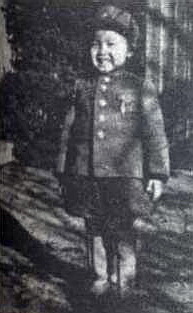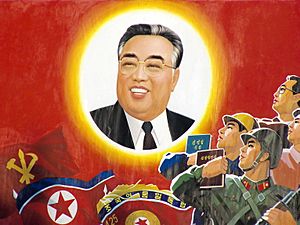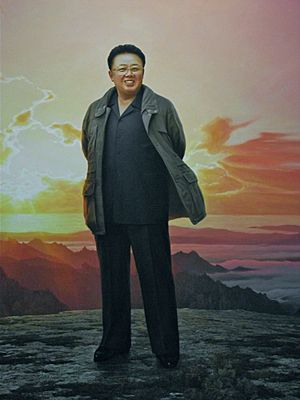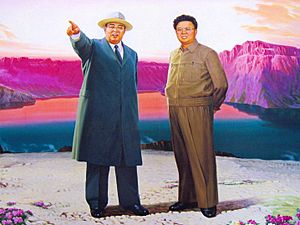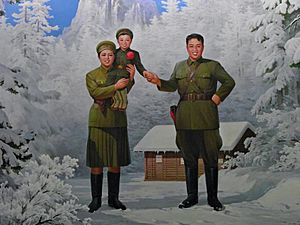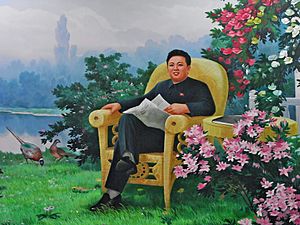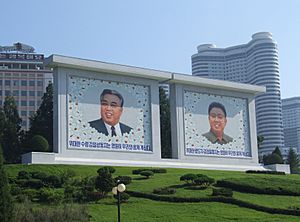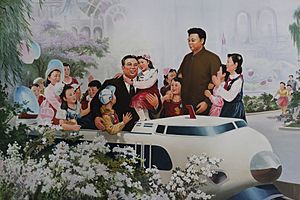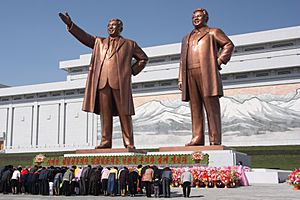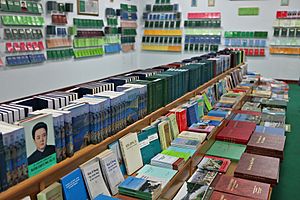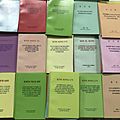Kim Jong-il facts for kids
Quick facts for kids
Kim Jong-il
|
|
|---|---|

Kim Jong-il on 24 August 2011
|
|
| Eternal General Secretary of the Workers' Party of Korea (Appellation) | |
| Assumed office 11 April 2012 |
|
| Supreme Leader of North Korea | |
| In office 8 July 1994 – 17 December 2011 |
|
| Premier | Hong Song-nam Pak Pong-ju Kim Yong-il Choe Yong-rim |
| Preceded by | Kim Il-sung (as President) |
| Succeeded by | Kim Jong-un |
| General Secretary of the Workers' Party of Korea | |
| In office 8 October 1997 – 17 December 2011 |
|
| Deputy | Kim Yong-nam Choe Yong-rim Jo Myong-rok Ri Yong-ho |
| Preceded by | Kim Il-sung |
| Succeeded by | Position abolished (Proclaimed Eternal Party General Secretary after his death) |
| Chairman of the National Defence Commission of North Korea | |
| In office 9 April 1993 – 17 December 2011 |
|
| Deputy | Jo Myong-rok |
| Preceded by | Kim Il-sung |
| Succeeded by | Position abolished as Kim Jong-il was declared as the Eternal Chairman on 13 April 2012 |
| Supreme Commander of the Korean People's Army | |
| In office 24 December 1991 – 17 December 2011 |
|
| Preceded by | Kim Il-sung |
| Succeeded by | Kim Jong-un |
| Chairman of the Central Military Commission of the Workers' Party | |
| In office 8 October 1997 – 17 December 2011 |
|
| Deputy | Kim Jong-un Ri Yong-ho |
| Preceded by | Kim Il-sung |
| Succeeded by | Kim Jong-un |
| First Vice Chairman of the National Defence Commission of North Korea | |
| In office 24 May 1990 – 9 April 1993 |
|
| Leader | Kim Il-sung |
| Preceded by | Position created |
| Succeeded by | O Chin-u |
| Personal details | |
| Born | 16 February 1941 Vyatskoye, Russian SFSR, Soviet Union (Soviet records) 16 February 1942 Baekdu Mountain, Japanese Korea (North Korean biography) |
| Died | 17 December 2011 (aged 70) Pyongyang, Democratic People's Republic of Korea |
| Resting place | Kumsusan Palace of the Sun, Pyongyang, Democratic People's Republic of Korea |
| Political party | Workers' Party of Korea |
| Spouse | Kim Young-sook (1974–2011) |
| Domestic partners | Song Hye-rim (1968–2002) Ko Young-hee (1977–2004) Kim Ok (2004–2011) |
| Children | Kim Sul-song Kim Jong-nam Kim Jong-chul Kim Jong-un Kim Yo-jong |
| Alma mater | Mangyongdae Revolutionary School Kim Il-sung University |
| Signature | |
| Military service | |
| Allegiance | |
| Branch/service | Korean People's Army |
| Years of service | 1991–2011 |
| Rank | Taewonsu (roughly translated as Grand Marshal or Generalissimo) |
| Commands | Supreme Commander |
Kim Jong-il (born February 16, 1941 – died December 17, 2011) was the second leader of North Korea. He became the country's leader after his father, Kim Il-sung, passed away in 1994. Kim Jong-il ruled North Korea until his own death in 2011. He was a powerful leader who was not chosen by public vote.
Kim Jong-il was born in Vyatskoye, Russia, which was then part of the Soviet Union. By the early 1980s, he was expected to become the next leader of North Korea. He took on important roles in the country's main political party and military. After his father, Kim Il-sung, died in 1994, Kim Jong-il took over.
He held many important positions. He was the General Secretary of the Workers' Party of Korea (WPK). He also led North Korea's National Defence Commission (NDC) and was the Supreme Commander of the Korean People's Army (KPA). The KPA is one of the largest armies in the world.
During Kim Jong-il's time as leader, North Korea faced many challenges. The country experienced a severe famine. There were also serious concerns about human rights. Kim Jong-il focused on a "military-first" policy, known as Songun. This policy gave the military a very strong role in the country. Some economic changes were also made, like opening the Kaesong Industrial Park in 2003. In 2009, North Korea's constitution was changed to call him and future leaders the "supreme leader." People often called him "Dear Leader" to tell him apart from his father, who was called "Great Leader."
In 2008, people outside North Korea wondered if Kim Jong-il was seriously ill because he didn't appear at important events. On December 19, 2011, North Korea announced that he had died two days earlier. His youngest son, Kim Jong-un, then became the new leader. After his death, Kim Jong-il was given special titles like "Eternal General Secretary" and "Eternal Chairman of the National Defence Commission." This was part of a tradition to honor past leaders of the Kim family.
Contents
Early Life and Family
Records from the Soviet Union show that Kim Jong-il was born in 1941. His birth name was Yuri Irsenovich Kim. He was born in a village called Vyatskoye, near Khabarovsk. At that time, his father, Kim Il-sung, was leading a military group made up of Chinese and Korean people living outside their home countries. Kim Jong-il's mother, Kim Jong-suk, was Kim Il-sung's first wife. His family called him "Yura." He had a younger brother named Kim Man-il, who was called "Shura."
In 1945, when Kim was four years old, World War II ended. Korea became free from Japan. His father went back to Pyongyang in September. Kim Jong-il returned to Korea in November by a Soviet ship. His family moved into a large house in Pyongyang. Sadly, his brother drowned there in 1948. Reports also say his mother died in 1949.
Education and Early Career
According to his official story, Kim Jong-il finished his main schooling between 1950 and 1960. He went to Primary School No. 4 and Middle School No. 1 in Pyongyang.
During his school years, Kim was very involved in politics. He was active in the Korean Children's Union and the Democratic Youth League of North Korea. He joined study groups to learn about political ideas. In 1957, he became the vice-chairman of his middle school's youth league. He tried to encourage his classmates to learn more about political ideas. Some reports also say he learned English in Malta in the early 1970s.
His father had married again and had another son, Kim Pyong-il. Since 1988, Kim Pyong-il has worked in North Korean embassies in Europe. He was even the North Korean ambassador to Poland. Some people think his father sent Kim Pyong-il to these distant places to prevent a power struggle between his two sons.
Becoming North Korea's Leader
On July 8, 1994, Kim Il-sung died at 82 years old from a heart attack. Kim Jong-il had been chosen to be his father's successor since 1974. He was also made commander-in-chief of the military in 1991. However, it took him some time to fully take control.
He officially became the General Secretary of the Workers' Party of Korea on October 8, 1997. In 1998, he was re-elected as chairman of the National Defence Commission. A change to the constitution declared this position to be "the highest post of the state." Also in 1998, the Supreme People's Assembly removed the president's job from the constitution. They named Kim Il-sung the country's "Eternal President" to honor him forever.
Officially, Kim Jong-il was part of a group of three leaders. This group included Premier Choe Yong-rim and parliament chairman Kim Yong-nam. Kim Jong-il led the armed forces. Choe Yong-rim managed the government and home affairs. Kim Yong-nam handled foreign relations. But in reality, Kim Jong-il had complete control over the government and the country.
Kim Jong-il was known for not being very good at managing the economy. North Korea's economy struggled a lot in the 1990s. This was mainly due to poor management. Also, North Korea had severe floods in the mid-1990s. This happened because the land was not managed well. Only 18% of North Korea's land is good for growing crops. The country also struggled to import goods needed for its industries. All these problems led to a severe famine. North Korea's economy was badly damaged. To make the country stronger and keep his power, Kim adopted a "Military-First" policy.
A report from 2004 stated that Kim's government was very strict. It said there were many political prisoners. There was no freedom of the press or religion. People could not oppose the government. The government controlled almost every part of life. Kim's government was also criticized for its role in the 1990s famine.
Foreign Relations
Kim was seen as a clever diplomat. In 1998, South Korean President Kim Dae-jung started the "Sunshine Policy." This policy aimed to improve relations between North and South Korea. It also allowed South Korean companies to start projects in the North. Kim Jong-il announced plans to bring in new technologies. He wanted to develop North Korea's software industry. Because of this new policy, the Kaesong Industrial Park was built in 2003. It is located just north of the border.
In 1994, North Korea and the United States signed an agreement. This agreement was meant to stop North Korea's nuclear weapons program. In return, North Korea would get help to build two power-generating nuclear reactors. They also received a promise that they would not be invaded. In 2000, after meeting with Madeleine Albright, Kim agreed to stop building missiles.
In 2002, Kim Jong-il's government admitted that it had been making nuclear weapons since the 1994 agreement. Kim's government said this secret production was needed for safety. They pointed to the presence of U.S. nuclear weapons in South Korea. They also mentioned new tensions with the United States under President George W. Bush. On October 9, 2006, North Korea announced that it had successfully done an underground nuclear test.
Public Image and Personal Life
Kim Jong-il was the center of a strong "personality cult." This was something he inherited from his father, Kim Il-sung. Kim Jong-il was often the focus of attention in North Korea. For his 60th birthday, huge celebrations happened across the country. In 2010, North Korean media reported that Kim's unique clothing style had become a global fashion trend.
Many people believe that North Koreans followed Kim Jong-il's personality cult out of respect for his father or fear of punishment. Media outside North Korea generally agree with this view. However, North Korean government sources say it was genuine admiration. A song called "No Motherland Without You" was made for Kim in 1992. It is often played on the radio and through loudspeakers in Pyongyang.
There isn't much official information about Kim Jong-il's marriages. But it is believed he was officially married twice. He had three known sons: Kim Jong-nam, Kim Jong-chul, and Kim Jong-un. His two known daughters are Kim Sul-song and Kim Yo-jong. He also had a younger sister, Kim Kyong-hui.
Like his father, Kim was afraid of flying. He always traveled by private armored train for trips to Russia and China. Kim was said to love movies. He reportedly had a collection of over 20,000 video tapes and DVDs. His favorite movie series included James Bond, Rambo, and Godzilla. He also liked Hong Kong action cinema. His favorite actors were Sean Connery and Elizabeth Taylor.
A news story in 2011 said that Kim Jong-il was a big fan of Elvis Presley. His home was filled with Elvis records. His movie collection included Presley's films. He even copied Elvis's look from his Vegas shows, with big sunglasses, jumpsuits, and hairstyle.
Even though Kim enjoyed foreign entertainment, his former bodyguard, Lee Young Kuk, said he only ate food and drinks made in North Korea. The only exception was wine from France. However, his former chef, Kenji Fujimoto, said Kim sometimes sent him around the world to buy different foreign foods.
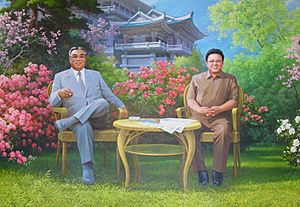
Kim reportedly enjoyed basketball. Madeleine Albright, a former U.S. Secretary of State, once gave him a basketball signed by NBA legend Michael Jordan. His official biography also claims that Kim wrote six operas. He also enjoyed putting on big musicals.
Charles Kartman, a U.S. diplomat, described Kim as a reasonable person during talks. He said Kim was direct but also had a sense of humor. He was also personally kind to his guests.
People who left North Korea claimed that Kim had 17 different palaces and homes across the country. These included a private resort near Baekdu Mountain, a beach house in Wonsan, and Ryongsong Residence. This last one was a palace complex near Pyongyang with many fences, bunkers, and anti-aircraft defenses.
According to the Sunday Telegraph, Kim had US$4 billion in European banks. This money was supposedly for him if he ever needed to leave North Korea. Most of this money was reportedly in banks in Luxembourg.
Death and Legacy
It was reported that Kim Jong-il died of a suspected heart attack on December 17, 2011, at 8:30 a.m. He was traveling by train outside Pyongyang. His youngest son, Kim Jong-un, became the new leader. North Korea's official news agency called Kim Jong-un the "Great Successor."
Kim Jong-il's funeral was held on December 28 in Pyongyang. A period of mourning lasted until the next day. South Korea's military was immediately put on high alert after the announcement. Its National Security Council held an emergency meeting. They were worried that a power struggle in North Korea could make the region unstable. Asian stock markets also dropped soon after the news, due to similar concerns.
On January 12, 2012, North Korea called Kim Jong-il the "eternal leader." They announced that his body would be preserved and shown at Pyongyang's Kumsusan Memorial Palace. Officials also planned to put up statues, portraits, and "towers to his immortality" across the country. His birthday, February 16, was declared "the greatest holiday of the nation." It was named the Day of the Shining Star.
In February 2012, on what would have been his 71st birthday, Kim Jong-il was given the highest military rank, Dae Wonsu, which means Grand Marshal. He had been named Wonsu (Marshal) in 1992. His father, Kim Il-sung, was promoted to Dae Wonsu then.
Also in February 2012, the North Korean government created the Order of Kim Jong-il in his honor. It was given to 132 people for helping to build a "successful socialist nation" and for improving defense.
Official Titles and Works
Kim Jong-il held many important titles throughout his life and even after his death:
- Party Center of the WPK and Member, Central Committee of the WPK (1970s)
- Dear Leader (Chinaehaneun Jidoja) (late 1970s–1994)
- Member Presidium of the Supreme People's Assembly of the DPRK
- Secretary Central Committee of the Workers' Party of Korea (1974–1997)
- Presidium member, WPK Central Committee (1980–2011)
- Supreme Commander Korean People's Army (December 25, 1991 – December 17, 2011)
- Marshal of the DPRK (1993–2011)
- Chairman, National Defence Commission (1993–2011)
- Great Leader (Widehan Ryongdoja) (July 1994 – December 2011)
- General Secretary Workers' Party of Korea (October 1997 – December 2011)
- Chairman Central Military Commission (DPRK) (October 1997 – December 2011)
- Eternal Leader (posthumous) (January 2012 – present)
- Generalissimo of the DPRK (posthumous) (January 2012 – present)
- Eternal General Secretary Workers' Party of Korea (April 11, 2012 – present)
- Eternal Chairman of the National Defence Commission (April 13, 2012 – present)
- Eternal leader of the Workers' Party of Korea (posthumous) (May 7, 2016 – present)
- Eternal leader of the Democratic People's Republic of Korea (June 29, 2016 – present)
North Korean sources say that Kim Jong-il published about 890 works between 1964 and 1994. According to the Korean Central News Agency (KCNA), the number of works from 1964 to 2001 was 550. In 2000, it was reported that the Workers' Party of Korea Publishing House had published at least 120 of his works. In 2009, KCNA stated that 354,000 copies of his books were translated into almost 70 languages. These books were published in about 80 countries.
The Selected Works of Kim Jong-il continues to be published, with 24 volumes so far. The Complete Collection of Kim Jong-il's Works is currently in volume 13. There is a "Kim Jong-il's Works Exhibition House" in North Korea. It is dedicated to his writings and holds 1,100 of his works and manuscripts.
When he was a teenager and in university, Kim Jong-il wrote poems. One famous poem is "O Korea, I will Add Glory to Thee". Kim Jong-il also wrote song lyrics. His first major writing about art was On the Art of the Cinema in 1973.
Images for kids
-
Kim talking with Russian President Vladimir Putin during their 2001 meeting in Moscow
-
Kim Ok, Kim's personal secretary, with U.S. Secretary of Defense William Cohen, 2000
See also
 In Spanish: Kim Jong-il para niños
In Spanish: Kim Jong-il para niños


